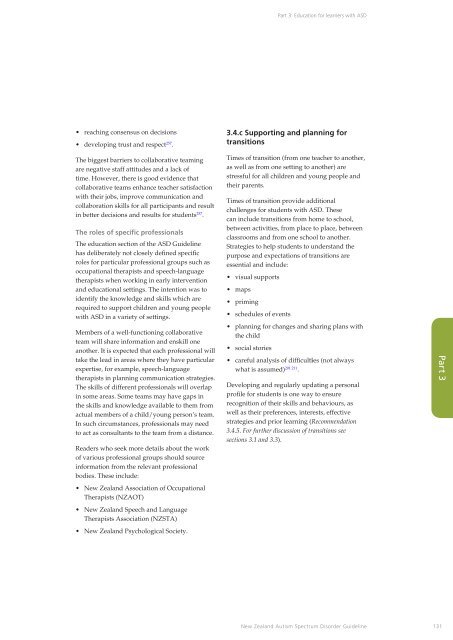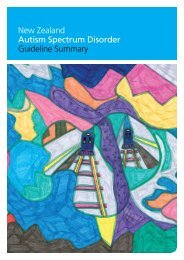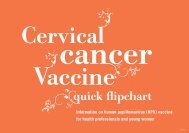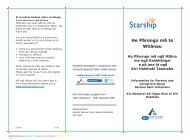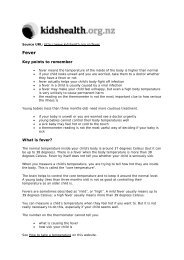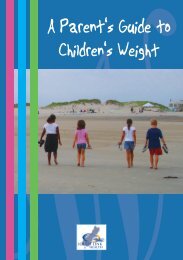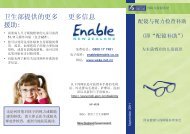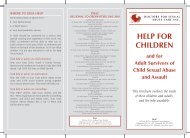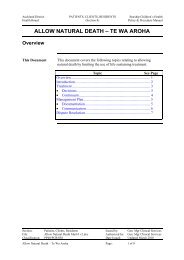New Zealand Autism Spectrum Disorder Guideline - Ministry of Health
New Zealand Autism Spectrum Disorder Guideline - Ministry of Health
New Zealand Autism Spectrum Disorder Guideline - Ministry of Health
You also want an ePaper? Increase the reach of your titles
YUMPU automatically turns print PDFs into web optimized ePapers that Google loves.
Part 3: Education for learners with ASD<br />
• reaching consensus on decisions<br />
• developing trust and respect 257 .<br />
3.4.c Supporting and planning for<br />
transitions<br />
The biggest barriers to collaborative teaming<br />
are negative staff attitudes and a lack <strong>of</strong><br />
time. However, there is good evidence that<br />
collaborative teams enhance teacher satisfaction<br />
with their jobs, improve communication and<br />
collaboration skills for all participants and result<br />
in better decisions and results for students 257 .<br />
The roles <strong>of</strong> specific pr<strong>of</strong>essionals<br />
The education section <strong>of</strong> the ASD <strong>Guideline</strong><br />
has deliberately not closely defined specific<br />
roles for particular pr<strong>of</strong>essional groups such as<br />
occupational therapists and speech-language<br />
therapists when working in early intervention<br />
and educational settings. The intention was to<br />
identify the knowledge and skills which are<br />
required to support children and young people<br />
with ASD in a variety <strong>of</strong> settings.<br />
Members <strong>of</strong> a well-functioning collaborative<br />
team will share information and enskill one<br />
another. It is expected that each pr<strong>of</strong>essional will<br />
take the lead in areas where they have particular<br />
expertise, for example, speech-language<br />
therapists in planning communication strategies.<br />
The skills <strong>of</strong> different pr<strong>of</strong>essionals will overlap<br />
in some areas. Some teams may have gaps in<br />
the skills and knowledge available to them from<br />
actual members <strong>of</strong> a child/young person’s team.<br />
In such circumstances, pr<strong>of</strong>essionals may need<br />
to act as consultants to the team from a distance.<br />
Readers who seek more details about the work<br />
<strong>of</strong> various pr<strong>of</strong>essional groups should source<br />
information from the relevant pr<strong>of</strong>essional<br />
bodies. These include:<br />
• <strong>New</strong> <strong>Zealand</strong> Association <strong>of</strong> Occupational<br />
Therapists (NZAOT)<br />
• <strong>New</strong> <strong>Zealand</strong> Speech and Language<br />
Therapists Association (NZSTA)<br />
• <strong>New</strong> <strong>Zealand</strong> Psychological Society.<br />
Times <strong>of</strong> transition (from one teacher to another,<br />
as well as from one setting to another) are<br />
stressful for all children and young people and<br />
their parents.<br />
Times <strong>of</strong> transition provide additional<br />
challenges for students with ASD. These<br />
can include transitions from home to school,<br />
between activities, from place to place, between<br />
classrooms and from one school to another.<br />
Strategies to help students to understand the<br />
purpose and expectations <strong>of</strong> transitions are<br />
essential and include:<br />
• visual supports<br />
• maps<br />
• priming<br />
• schedules <strong>of</strong> events<br />
• planning for changes and sharing plans with<br />
the child<br />
• social stories<br />
• careful analysis <strong>of</strong> difficulties (not always<br />
what is assumed) 201 211 .<br />
Developing and regularly updating a personal<br />
pr<strong>of</strong>ile for students is one way to ensure<br />
recognition <strong>of</strong> their skills and behaviours, as<br />
well as their preferences, interests, effective<br />
strategies and prior learning (Recommendation<br />
3.4.5. For further discussion <strong>of</strong> transitions see<br />
sections 3.1 and 3.3).<br />
Part 3<br />
<strong>New</strong> <strong>Zealand</strong> <strong>Autism</strong> <strong>Spectrum</strong> <strong>Disorder</strong> <strong>Guideline</strong> 131


